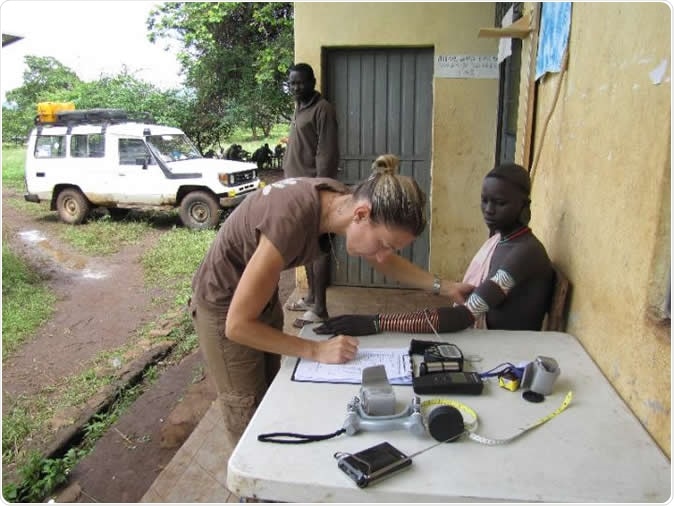Human populations vary vastly in skin tones. European populations have been studied and some of the genes that determine skin color have been found. A latest study in a varied African population has found the specific and new genetic variants that could determine skin color and skin pigmentation. The study report is published in the journal Science.

University of Pennsylvania researchers studied the genetics behind skin pigmentation of diverse African populations, finding new genetic variants associated with skin color. Here, senior research scientist Alessia Ranciaro measures the skin reflectance of a man from a Nilo-Saharan group. Members of this population tend to have very dark skin pigmentation. Image Credit: Courtesy of the Tishkoff lab
A group of researchers led by University of Pennsylvania geneticists have determined these genetic variants that could help understand the evolution of skin tones and also help understand the risks of skin cancers and other conditions. Nicholas Crawford, a postdoctoral fellow was the first author of this study and there was a multi-institutional, international team of researchers working in collaboration.
Sarah Tishkoff, a Penn Integrates Knowledge Professor said that the team had identified these genetic variants that could determine one of the “most strikingly variable traits in modern humans”. She explained that people think all African populations have similar dark skin tones. The actual fact is that they have a large variation of skin tones that could range from as light as the Asian populations to the darkest skin tone. An analysis of the genes has given clues towards the evolution of light and dark skin “before the origin of modern humans”. She explained that skin color is an adaptive trait in humans. This study would show how this adaptive trait could play a role in diseases.
Researchers explain that darker skin prevents the negative effects of the sun’s ultraviolet rays. Lighter skin on the other hand is more efficient in producing vitamin D from sun’s rays in regions where sunlight is lower (colder regions with low sunlight).
For this study the team used a color meter to measure the light reflecting from the skin tones. They included over 2,000 Africans from ethnically and genetically diverse populations. The tones were taken from the inner arms of the participants where the exposure to sun is minimal. The levels of skin pigment melanin were estimated from the skin tones measured. The darkest skin tones were found in the Nilo-Saharan pastoralist populations in eastern Africa. On the other hand the San hunter-gatherer populations in southern Africa had the lightest skin tones. From the participants, genetic analysis was done for around 1600 participants. From the genetic fingerprints, more than 4 million single nucleotide polymorphisms or SNPs were estimated. SNPs or snips are regions where a single letter is different in the genetic code (the genetic code is made up of 4 letters – A, T, G, C which are nucleotides). From this data the team did a genome-wide association study. They noted that there are four regions of the genome where variations could predict skin color changes.
One of the strongest associated genetic regions was at the SLC24A5 gene. Variations of this gene have been found previously to affect skin color of European and some southern Asian populations. These changes date back to over 30,000 years back. The variations at this gene are found in people from Ethiopia and Tanzania.
These people could have their ancestors from Southeast Asia and the Middle East from where the populations could have migrated to Africa, speculate researchers. The MFSD12 gene was another strong marker. This gene is associated with vitiligo found the researchers. Vitiligo is a condition where there are patchy discolorations of the skin due to lack of melanin pigment. Mutations in this region of the genome were seen most commonly in the Nilo-Saharan populations with the darkest skin and the sub-Saharan populations. Variants of this gene were also found among the South Asian Indian and Australo-Melanesian populations who have the darkest skin complexions outside of Africa. Tishkoff explained that several genetic traits were shared by populations of Melanesia and Australia and some sub-Saharan Africans.
Other genes of interest were MFSD12, OCA2, and HERC2 associated with light skin pigmentation as was seen in the African San population shared by Europeans. Tishkoff said this study not only shows how diverse African populations are but also challenges the existing ideas regarding race.